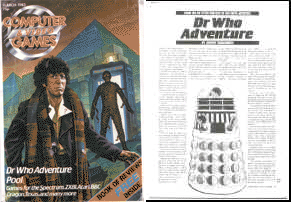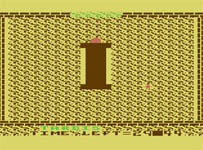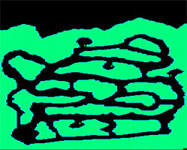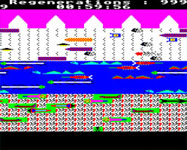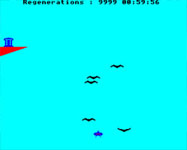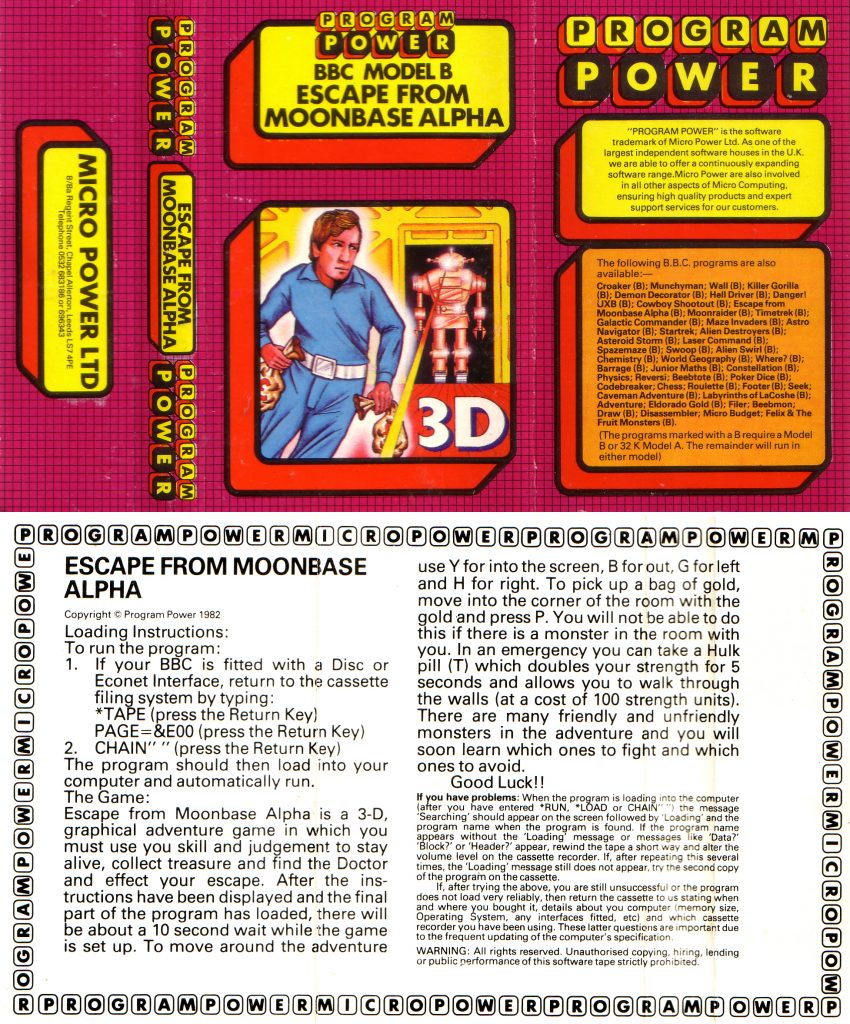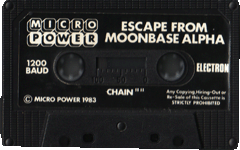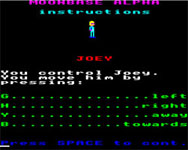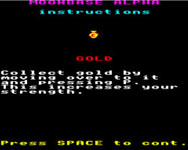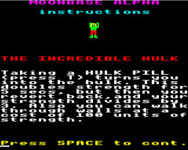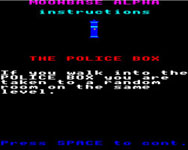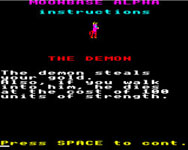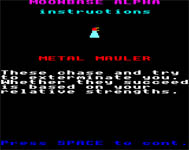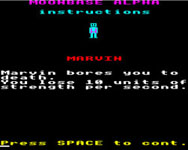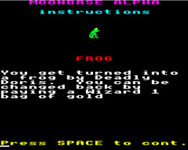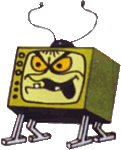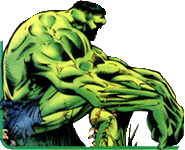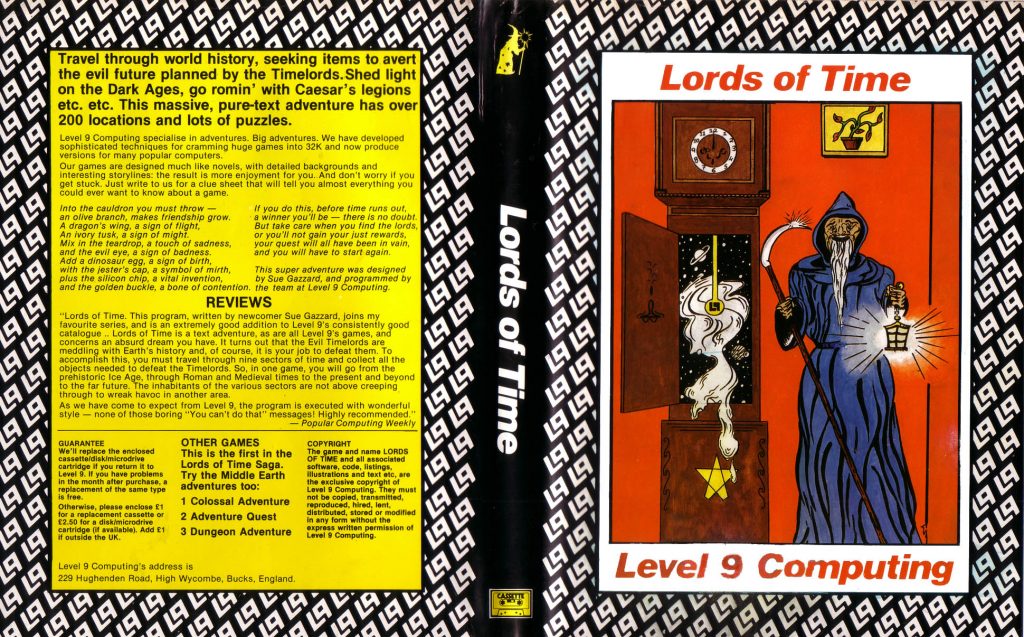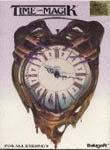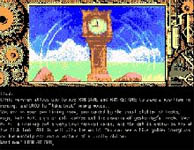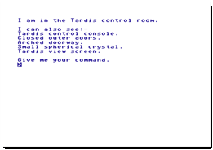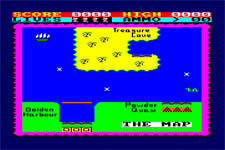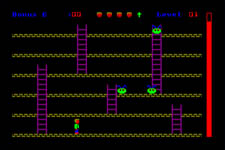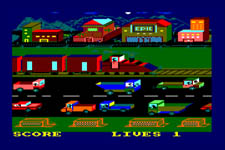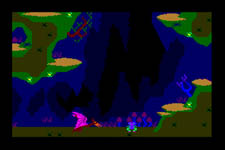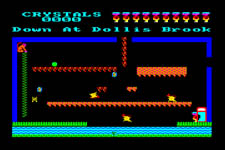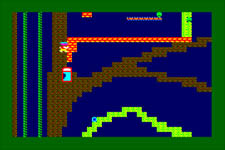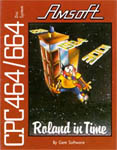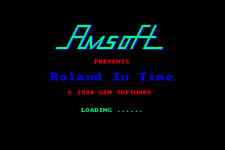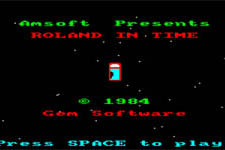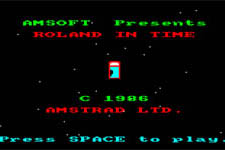1983 – Dr Who Adventure
Atari 800 BASIC (Code printed in magazine for hand typing)
Programmer: Jeremy Guggenheim
Published in the March 1983 issue of Computer & Video Games, this program had to be typed into an Atari 400 or 800 before it could be played. The storyline was printed in the magazine before a full listing…
Another time, another place… the Doctor is on the move once again and this time you can become one of his traveling companions. This graphics adventure is based on the classic sci-fi TV series Dr Who. In it the good Doctor is trapped on the planet Strardos IV in a pyramid built by his arch-enemy, the Master.
The Master plans to destroy the planet – and the Doctor – with a time bomb. He has stolen the Doctor’s time drive unit from the Tardis – and without this the Doctor cannot escape the doomed planet – but he can only do this by killing the Master.
Although well meaning, and important for being the first time Doctor Who had appeared on computer screens, this does just come down to little man running around lots of identical rooms and then freezing for no apparant reason. Retro is one thing, but even for the time this was nothing special.
Controls
Cursor keys or joystick.
Downloads
For the game itself, please visit www.justyce.org, where the webmaster has uploaded not only the program as it appeared in the magazine, but also a “corrected” version that solves some graphical glitches.
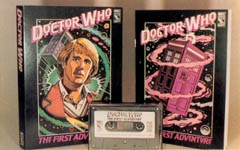
BBC Micro (Cassette)
Programmer: Jeremy Ruston
Publisher: BBC Software
Format Developed By: Pluto
Cover Art By: Martin Brownfield
Black Guardian Created By: Graham Williams*
*not involved in production of the game, but received a credit and (presumably) royalties.
An arcade game divided into four “episodes”, each based on classic arcade games themselves (although often missing something of the playability of the original versions). A booklet contained a fictional scenario, as did the game’s opening:
Time itself is running to an end!
In less than one galactic hour, you must retrieve the key to time and take it to the centre of the universe,where it can be used to initiate the Second Age of Time.
If you succeed,you will be awarded a place in the Gallifreyan Time Academy and given an all-time honorary rating. If you do not succeed,then Time will come to a halt and the universe will become silent and dead.
If you fail in a particular episode, you may regenerate and begin that episode again.(However,regenerating takes three minutes of your remaining time.) You also have a micimum of fifteen regenerations. You must complete each episode before going on to the next one.
You are now ready to embark on your journey.
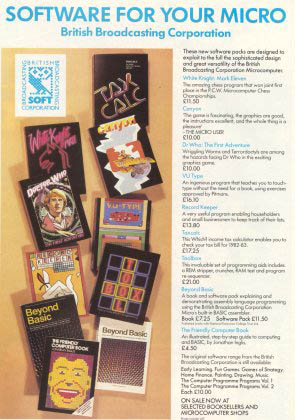
Episode 1, The Labyrinth of Death, is a PacMan clone in which the Doctor drives a buggy around a maze of underground tunnels in order to find the three segments of the key to time, avoiding poisonous worms on the way.
The Prison, Episode 2, is based on Frogger, and the Doctor carries explosives across a highway, a moat and a forecourt in order to blow up a wall and rescue a companion.
Next, the Doctor faces The Terrordactyls (Episode 3) in a Space Invaders-esque shoot-em-up, as he tries to get back to the TARDIS.
Finally, the Doctor searches for The Box of Tantalus in Episode 4. Aliens hide in a 3x3x3 grid, and the Doctor must detect and destroy them, using a Battleships style approach.
Controls
Left: Z
Right: X
Up: ;
Down: /
Fire: Return
Cheats
Some ROMs of this game available on the ‘net are hacked, allowing level selection upon start.
1983 – Escape From Moonbase Alpha
BBC Micro/Electron (Cassette and Disc)
Publisher: Micro Power Ltd
(C) 1982 Program Power
Uncredited: Programmed by Adrian Stephens
The player is Joey, and has been left on Moonbase Alpha as the game’s introduction sequence explains:
You have been left on Moonbase alpha by your mutinous crew. Your only means of escape is the Doctor and he wants payment
In your quest you will meet many hazards, and you will die if your strength reaches zero.
The object of the game is to find The Doctor (somewhere on level 7) and pay him 10 bags of gold so he can transport you out of the building in his Police Box.
The blurb on the box for the disc version goes into more depth:
Fight for your life in this exciting, all action ‘3-D’ graphics adventure. You have been left for dead by your crew members in the vast complex known as Moonbase Alpha. Dash from room to room, up and down stairs and ladders in your attempt to escape. Search for the kindly doctor, somewhere on level seven, and if you have collected enough gold, he will transport you to safety in his time machine. If you think that sounds easy, you haven’t bargained for the Green Grappler, Deadly Doris, the Metal Mauler, Demon and Marvin. If you get into difficulties the Wizard is there to help you, and as a last resort, you may take a pill and increase your strength by turning into a Hulk. You may never find your way out, but you will have lots of fun trying!
Unusually for a BBC game, this is very fast moving, but with a near-impossible difficulty curve and a randomised map that releaves the temptation to return regularly and try again. The game was originally made (alongside Killer Gorilla) as a homebrew program by “bedroom coder” Adrian Stephens – friends pursuaded him to submit his work to Micropower (who had begun publishing in 1983, and would remain successful through to 1987), and they paid him £400 for the rights to release each game. He followed this up with a string of games for other publishers, including the acclaimed Mr Ee, and Donkey Kong Jr for the Atri.
The game features various characters based on TV shows, but carefully avoids using trademarks. The game’s intro sequence introduces them to us all:
The Police Box is clearly the TARDIS, Marvin is based on the character from The Hitch-Hiker’s Guide To The Galaxy, Deadly Doris is similar to Evil Edna from Willo The Wisp, the less said about the Metal Mauler the better and the Hulk is probably a bit Incredible. Not to mention the title’s reference to Space: 1999.
Controls
Left: Z
Right: X
Up: *
Down: ?
Get Gold: G
Turn into Hulk: H
1983 – Lords of Time
Commodore C64, Amstrad CPC464, BBC Micro, Atari 800, Spectrum 48K/128K (Disc)
Publisher: Level 9 Computing
Game Design: Sue Gazzard
Implementation: Pete Austin
Transport to Your Computer: Mike Austin
A-Code Compiler and System: Mike Austin
Data Compiler: Pete Austin
Additional Expertise: Ian Buxton
Instruction Booklet: Pete Austin
Artwork: Tim Noyce
Released with added graphics in an omnibus with 1985 sequel Red Moon and 1986’s The Price of Magic as Time and Magik on Commodore and Amstrad only. Ruth Pracy added text to link the three.
Besides references to Timelords (sic), who seem to be a little more evil than the versions in Doctor Who, and a Cyberman, the central character travels through time and space in inside a “cramped” Grandfather clock.
Controls
Type-in game
Solution
LOOK, EXAMINE PICTURE, TAKE HOURGLASS, N, TAKE CANDLE, TAKE MATCHES, LIGHT CANDLE, EXAMINE CLOCK, WIND CLOCK, IN, TURN COG 1, SWING PENDULUM, N.
W, W, OPEN DOOR, OPEN DOOR, W, UP, N, TAKE RUCKSACK, WEAR RUCKSACK, TAKE ROPE, EXAMINE RUBBISH, TAKE TIN, OPENER S, W, TAKE JEWELLERY CASE, E, DOWN, TAKE SPEAR, OPEN DOOR, E, E, E, N, N, TAKE PICK, TAKE PLANKS, S, S, W, W, OPEN DOOR, W, S, OPEN CUPBOARD, TAKE CATFOOD, W, TAKE LOOKING GLASS, TAKE METRONOME, OPEN DOOR, W, NW, TAKE VALERIAN, SE, W, UP, S, WAVE VALERIAN, N, N, TIE PLANKS TOGETHER, DROP PLANKS, W, EXAMINE NARCISSUS, GIVE LOOKING GLASS, ACROSS, S, UP, E, SW, WAVE LODESTONE, UNLOCK DOOR, IN, TAKE AXE, TAKE SHOVEL, OPEN DOOR, OUT, NE, W, UP, S, CHOP WILLOW, TAKE TEARDROP, DROP AXE, N, UP, E, SW, E, E, EXAMINE COMPOST, EXAMINE COMPOST, E, EXAMINE PORSCHE, TAKE PETROL, DOWN, DROP LODESTONE, DROP JEWELLERY CASE, DROP TEARDROP, DROP HOURGLASS, DROP METRONOME, DROP VALERIAN, SCORE (SHOULD BE 150/1000), TURN COG 2, SWING PENDULUM, N
N, N, N, POUR PETROL, LIGHT MATCH, LIGHT PETROL, TAKE COAT, WEAR COAT, TAKE TUSK, E, UP, UP, TAKE BONE, UP, OPEN TIN, GIVE TIN, TAKE TOOTH, IN, S, SHOUT, TAKE ICICLE, N, E, E, GIVE BONE, E, BREAK WALL, S, TAKE CANDELABRA, N, W, S, DROP ICICLE, NW, NW, BREAK CUBE, S, IN, W, DOWN, DOWN, DROP TUSK, DROP CANDELABRA, DROP SWORD, SCORE (SHOULD NOW BE 225/1000), – TURN COG 1, SWING PENDULUM, N.
W, W, OPEN DOOR, W, W, OPEN DOOR, W, SW, E, E, EAT MUSHROOM, LOOK, GIVE TOOTH, NO, YES, E, DOWN, DROP SPEAR, DROP SILVER COIN, TURN COG 3, SWING PENDULUM, N.
W, W, E, E, E, E, W, W, W, W, W, TAKE LEAVES, TAKE MIRROR, WAVE LEAVES, E, WAVE MIRROR, E, UP, IN, DROP MIRROR, N, TAKE EGG, N, TAKE STONE POT, N, TAKE PEBBLE, E, SE, TAKE STONE CLUB, E, THROW PEBBLE, E, TAKE FIGURINE, W, SE, THROW CLUB, S, SAY EUREKA, IN (you see a sign spelling ‘JWAAMTETS’ unscramble the letters to spell ‘JAMES WATT’), SAY JAMES WATT, IN, TAKE WHEEL, DOWN, DROP FIGURINE, DROP NUGGET, DROP EGG, DROP STONE POT, DROP TIN OPENER, SCORE (SHOULD NOW BE 350/1000), TURN COG 4, SWING PENDULUM, N.
N, GIVE FUR COAT, S, SE, E, E, DIG, DIG, TAKE PARCHMENT, W, READ PARCHMENT, SW, PUSH STONE, W, W, W, W, UP, UP, DROP LUR, E, OPEN CHEST, W, TAKE LUR, PLAY LUR, IN CHEST, TAKE (OBJECT) (whatever has been stolen from you) PULL HANDLE, DROP LUR, DROP OLIVE BRANCH, DROP PARCHMENT, SCORE, (SHOULD NOW BE 400/1000), TAKE NUGGET, TAKE SWORD, TURN COG 5, SWING PENDULUM, N.
N, EXAMINE MILESTONE, TAKE MILESTONE, E, OPEN DOOR, IN, TAKE ALE, GIVE NUGGET, TAKE ALE, OPEN DOOR, OUT, E, E, E, GIVE ALE, EXAMINE FOOD, W, W, N, E, E, GIVE FOOD, YES, TAKE WING, TAKE FROG, KISS FROG, S, IN, TAKE GAUNTLET, SE, W, TAKE ARMOUR, WEAR ARMOUR, S, W, W, W, DOWN, DOWN, DIG, DIG, TAKE COFFER, DIG, DROP COFFER, DROP ARMOUR, DROP GAUNTLET, DROP WING, DROP MILESTONE, SCORE (SHOULD NOW BE 475/1000), TURN COG 6, SWING PENDULUM, N.
N, W, S, TAKE DRINKING HORN, TAKE SWEETMEATS, N, E, E, S, TAKE PLAYING CARDS, SHUFFLE CARDS, TAKE JOKER, TAKE BELL, RING BELL, GIVE JOKER, N, W, UP, UP, N, W, S, TAKE RUG, S, GIVE SWEETMEATS, OPEN OTTOMAN, EXAMINE OTTOMAN, TAKE JEWELLED CROWN, N, N, E, E, S, S, TAKE LUTE, PLAY LUTE, N, N, W, S, PLAY LUTE, E, W, W, SW, E, N, SE, IN, DRINK WATER, N, DROP DRINKING HORN, DROP BELL, DROP CARDS, DROP CAP, DROP RUG, DROP JEWELLED CROWN, DROP LUTE, SCORE (SHOULD NOW BE 625/1000), TAKE GAUNTLET, TAKE SILVER COIN, TURN COG 7, SWING PENDULUM, N.
W, W, GIVE SILVER COIN, E, N, UP, UP, WEAR GAUNTLET, TAKE STAR, DOWN, DOWN, S, E, E, N, N, OPEN DOOR, N, W, TAKE EMERALD, E, N, TAKE MATTRESS, TAKE ROCKET, S, OPEN DOOR, S, S, S, E, DOWN, S, E, TAKE LIGHTSABRE, W, S, OPEN DOOR, W, TAKE PHIAL, FIRE ROCKET, N, GIVE GROAT, N, FIGHT CYBERMAN, E, EXAMINE WORKBENCH, TAKE SCREWDRIVER, W,, S IN, DOWN, TAKE RUBY, UP, OUT, N, OPEN ROBOT, EXAMINE ROBOT, TAKE SILICON CHIP, S, IN, DOWN, DOWN, DROP RUBY, DROP SCREWDRIVER, DROP CHIP, DROP ROCKET, DROP LIGHTSABRE, DROP MATTRESS, DROP STAR DROP EMERALD, DROP GAUNLET, SCORE (SHOULD NOW BE 775/1000), TAKE DRINKING HORN, TURN COG 8, SWING PENDULUM, N.
N, W, IN, KNEEL, PRAY, OUT, E, N, N, N, TAKE BUCKLE, S, S, S, NE, E, IN, TAKE NET, TAKE TRIDENT, OUT, W, SW, S, S, IN, THROW NET, THROW TRIDENT, WEAR SANDALS, TAKE BUCKLE, OPEN DOOR, OUT, E, N, NE, NE, NE, FILL HORN, S, PULL GRATE, S, S, DRINK WATER, W, W, S, DROP SANDALS, DROP HORN, DROP BUCKLE, DROP MATCHBOX, DROP WHEEL, SCORE (SHOULD NOW BE 825/1000), TAKE TEARDROP, TAKE TUSK, TAKE EGG, TAKE OLIVE BRANCH, TAKE WING, TAKE CAP, TAKE CHIP, TAKE BUCKLE, TAKE MILESTONE, TURN COG 9, SWING PENDULUM, N.
S, DROP MILESTONE, S, S, S, DOWN, W, S, DIG, TAKE BOTTLE, N, E, S, UNLOCK CAGES, S, UNLOCK BARS, E, E, IN, DOWN, DOWN, DROP BOTTLE, E, E, UP, UP, UP, TAKE CLOAK, WEAR CLOAK, OPEN TRAPDOOR, UP, UP, E, THROW TEARDROP, THROW TUSK, W, E, THROW EGG, THROW OLIVE BRANCH, W, E, THROW WING, THROW CAP, W, E, THROW CHIP, THROW BUCKLE, W, E, THROW BOX.
1984 – The Key to Time
ZX Spectrum 48K, Commodore C64 (Cassette)
Publisher: Lumpsoft
Author: Dr PJR Harkin, using the Quill system
A simple enough text adventure coded by Dr Harkin (who these days spends his time specialising in medicine and pathology at Leeds University), set across various times and places, with a great deal of variety available and several veiled (and some fairly blatant) references to the show. From the opening to the game:
The Time Storms have affected the ability of the Doctors current persona to operate properly. Because of the nature of the emergency, the High Council of the Time Lords have authorised that control is passed to you.
This is contrary to the First Law of Time, but desperate situations require desperate remedies! Good Luck, Doctor.
(You’re going to need it!) In the Adventure, you must guide your earlier persona by sending him messages through this Time Lord telepathic controller, cunningly disguised as a Sinclair Spectrum.
The game features the player searching for the five (*ahem*) segments of the Key to Time, and was dedicated to the memory of William Hartnell.
Controls
Type-in game
A Partial Walkthrough…
Get Crystal, (go to library and play crystal in hologram player), Press button, Pull Lever.
SKARO
Exit, E, N, Get tin, S, E, S, Get Hacksaw, Open tin, N, E, Use tin on eye, Get Davros statue [first segment], W, W, W, Enter TARDIS, Drop hacksaw, Drop statue. Pull lever, Push button, Push button, Pull lever
FIELD
Exit, N, Tent, Get torch, S, W, Light torch, Enter crack, Get skeleton, Get bones, E, E, Enter stream, Get fish, Eat fish, Dive into stream, Get nugget, Up, W, S, Use gold on Cyberman, Get core, S, Use machine, Get skull [second segment], N, N, W, W, Enter crack, E, S, Enter TARDIS, Drop torch, Drop bones, Drop nugget, Drop core, Drop skull, Pull lever, Push button, Push button, Pull lever
SENSORITE TEMPLE
Exit, Read sign (“something” is machines, ensure you don’t have the Time Scanner), N, N, W, Get robes, Wear robes, N, N, Get bell, S, U, Get beef [third segment], N, Ring Bell, Shout, Exit, E, Enter TARDIS, Drop robes, Drop bell, Drop beef, Pull lever, Push button, Push button, Pull lever
ZOO
Exit, Read sign, Enter turnstile, E, Enter shop, Get panda, Examine panda, N, Enter Animal House, E, Get boots, Wear boots, Get rope, W, S, W, Enter aquarium, Enter pond, Get coin, S, S, Enter cafe, Get bananas, Give coin, N, E, Enter Animal House, Enter cage, Drop bananas, Get key, S, Open door, Enter door, Get meat, S, S, Tie rope, To the tree, Enter pit, Enter hole, Drop meat, Get porridge [fourth segment], W, Climb rope, Enter tree, Enter nest, Read sign, Wait, Enter TARDIS, Drop key, Drop boots, Drop porridge, Drop panda, Pull lever, Push button, Push button, Pull lever
GALLIFREY
Exit, Help, E, Enter door, S, Sit in chair, Get cushion, Get sash, Drop cushion, Get up, S, Sit on bed, Get pillow, Get rod, Drop pillow, Get up, N, N, Exit, E, E, S, Examine computer, N, N, Enter cell, Get key, Say Prydonian, S, Enter Dais, Put rod in hole, Get rod, Enter stairs, unlock safe apparently – from the point on, TME is a little lost – if you can figure out the final few moves, please contact us!
Review by Sarah Hadley for TME
Extremely simplistic plotting and vocabulary limit what might have been a nice, fun game. Rescuing the five Doctors would be quite easy if you could actually think up an alternative to ‘tie rope around tree’ or ‘throw gold at Cyberman’ which the game accepts. Whoever wrote this didn’t have much of a puzzle instinct in him, because not only is the game completely about getting items and using them in the right places, every item you’ll need for each ‘world’ you travel to are found on that world! All of the items needed to complete the Dalek city world are in the Dalek city, etc. OK, but only as a time waster. The only really fun thing about it is what happens if you type in swear words (try it and see…). The Seven Doctors is a splendid example of how this same theme could’ve been done so much better.
Review by Richard Price for Sinclair User, December 1984
Knock, knock, Who’s here. The Doctor’s back, in search of The Key to Time. This new text adventure from Lumpsoft features the veteran time traveller and many of his oldest enemies, battling it out through time and space. Davros, Daleks, Cybermen and fellow time-lords all show up as you steer your Tardis through the ages. With the aid of a timescanner you must discover the scattered pieces of the great key and presumably save the Universe into the bargain. Before you can begin the quest you will have to learn how to operate the Tardis. Addicts of the TV series will find themselves in a well-known environment, but the program is very friendly and will give considerable help to those who are less familiar with the bumbling doctor. The program is responsive and versatile whilst the riddles are by no means obvious. It will get you zipping back and forth through time like nobody’s business. The Key to Time is good-humoured, well written and a joy to play. Gilbert factor: 7.
Review from Crash Issue 12, January 1985
The Key To Time is Lumpsoft’s first adventure and is all about a time traveller who was all the rage when people used to watch television. The loading screen shows a picture of a police box and funny little robots with a bad case of metallic pimples and tunnel vision compounded by the position of their only eye on the end of a stalk.
Apparently it is a bad time for time travellers what with time storms distorting travel coordinates which might lead anywhere and it proves imperative that someone recovers the object that can dispel the storms for good. At a meeting of the High Council of Time Lords one senior member asked, “Who can dispel the time storms?” But this was taken as a command by the others and so you, The Doctor, ended up with the job.
On your first attempt at the game it’s better to ask for HELP rather than STARTing straight off so you can gather some useful information. “In this adventure you must guide your earlier persona by sending him messages through this Time Lord telepathic controller, cunningly disguised as a Sinclair Spectrum.” Here you are told of the game’s intricacies including a timely list of recommended verbs including a general HELP, a more specific HELP(TIMESCANNER) and WAIT. The HELP is not as useful as it could be because it only results in a random selection from three or four phrases, one of which reads “Never eat anything bigger than your head”, a saying reminiscent of the work parodied by Lumpsoft’s next program to be released, Malice in Wonderland. The other, more specific help command is very useful in that constructions like HELP(DALEK) give encyclopedic information concerning a certain object or creature, eg. Cybermen are allergic to gold. I really do like this kind of encyclopedic reference material as it was what we all thought computers were about, indeed what they are good at, until the limitations of micro memory become apparent. In this respect, I can’t wait to see what adventure games the QL can produce. The WAIT command begins mimicking The Hobbit but soon departs with an amusingly prolonged diversion.
The vocabulary is very friendly with constructions such as GO(TARDIS) and ENTER(CRACK) equally helpful and the plot is similarly responsive; everything can be examined and if you look at the screen you find “The Tardis materialised. Atmosphere: breathable.”. Swearing will bring the wrath of Mary Whitehouse down upon your head leaving you to regenerate into your next persona, perhaps this time the chap who is a trifle absent-minded and plays a pipe.
Time travel is the core of the game and if you find play relatively easy as I did, then you will proceed quite quickly through the five time zones, although you may well use up a few of the Doctor’s characters. Moving through the likes of Daleks and Cybermen you arrive at Gallifrey where you enter, presumably, the final stages around the president’s office. If the game’s tricky moments hinder progress then you may have time to ponder on the difficulty of getting any score higher than 0 or how to travel from one time zone to another in the Tardis, an operation which involves a tricky combination of lever pulling and button pressing.
The Key To Time is a very worthy effort from Lumpsoft combining a friendly response with an interesting plot and amusing interludes. A text-only Quilled game with a familiar theme but very well executed.
COMMENTS
Difficulty: mostly easy
Graphics: none
Presentation: very good
Input facility: verb/noun, pretends to be more complex but other words are ignored
Response: very fast
General rating: good
Atmosphere 7
Vocabulary 7
Logic 8
Debugging 10
Overall value 7
1984/5 – Roland in the Caves, Roland in Space, Roland in Time
Amstrad CPC464 / Amstrad CPC6128 (Cassette and Disc)
Publisher of Roland in the Caves and Roland in Space: Indescomp (Amsoft/Gemsoft)
Publisher of Roland in Time: Amsoft (C) Amstrad Ltd
Roland was somewhat a precursor to the game mascots of the 90s – Nintendo’s Mario, Sega’s Sonic and so on. Several games were produced in 1984 (and one in 1985), each using ‘Roland’ (named after Amstrad boss Roland Perry), in whichever guise was necessary, as the hero.
Roland started life in 1984 with Computersmith’s Roland Ahoy, in which the player controlled a boat. Roland himself was then seen for the first time in Gem Software’s Roland Goes Digging, which was based on a classic arcade game and featured a very human looking Roland. Epicsoft/Egypt also had a go that year, when Roland became a stickman for Roland on the Run, programmed by Said A Abouelhassan. Indescomp then took over and turned the character into a chunky bloke for Roland on the Ropes (programmed by Paco Suarez, Fernando Rada, Caemio Cela and Carlos Granddos)
They then introduced the Doctor Who element with Roland in the Caves (programmed by Paco Suarez again, with graphics by Juanjo Redando), in which Roland is a bizarre purple bug that can jump huge distances (down to being able to mutate to look like the local life forms, supposedly). The story outline for this claims he has fallen into the caves when his telephone box crash lands. Roland’s final outings were Roland in Time (1984) and Roland in Space (1985). Both of these games cemented the link by featuring Roland (this time as a squat little man) in a time-travelling red telephone box, and the latter actually used the Doctor Who theme (in stereo, thanks to the marvels of the Amstrad’s sound chip) on the title screen. The player could enter the telephone box whenever they wanted and travel to a different destination. Roland in Space featured Sol 3, Pollu 3, Algol 6, Polaris 4, Arcturis 7, Betelgeuse 2 and Alpha Centauri 4, all multi-directional scrolling landscapes scattered with crystals. The aim was simply to collect as many crystals as possible in order to defeat the evil Maestro, whose name is thought to be a reference to the Master.
Roland in Time appears to have been issued three times..:
Controls for Roland in the Caves
Left: Z
Right: \
Scroll: Cursor Keys
Abandon: A
Game: G
Controls for Roland in Space and Roland in Time
Left: Q
Right: W
Jump: Space
Roland in Time Cheat
Instead of loading the game as normal, insert the cassette (or ROM), type in and run the following programme for infinite lives:
10 MEMORY 4999
20 LOAD “ROINTIME”, 5000
30 POKE 5850,167
40 CALL 5000
Roland in Space Cheat
Press TAB E G J K < and M while on a planet to allow you to pass any hazard and fall any distance.

